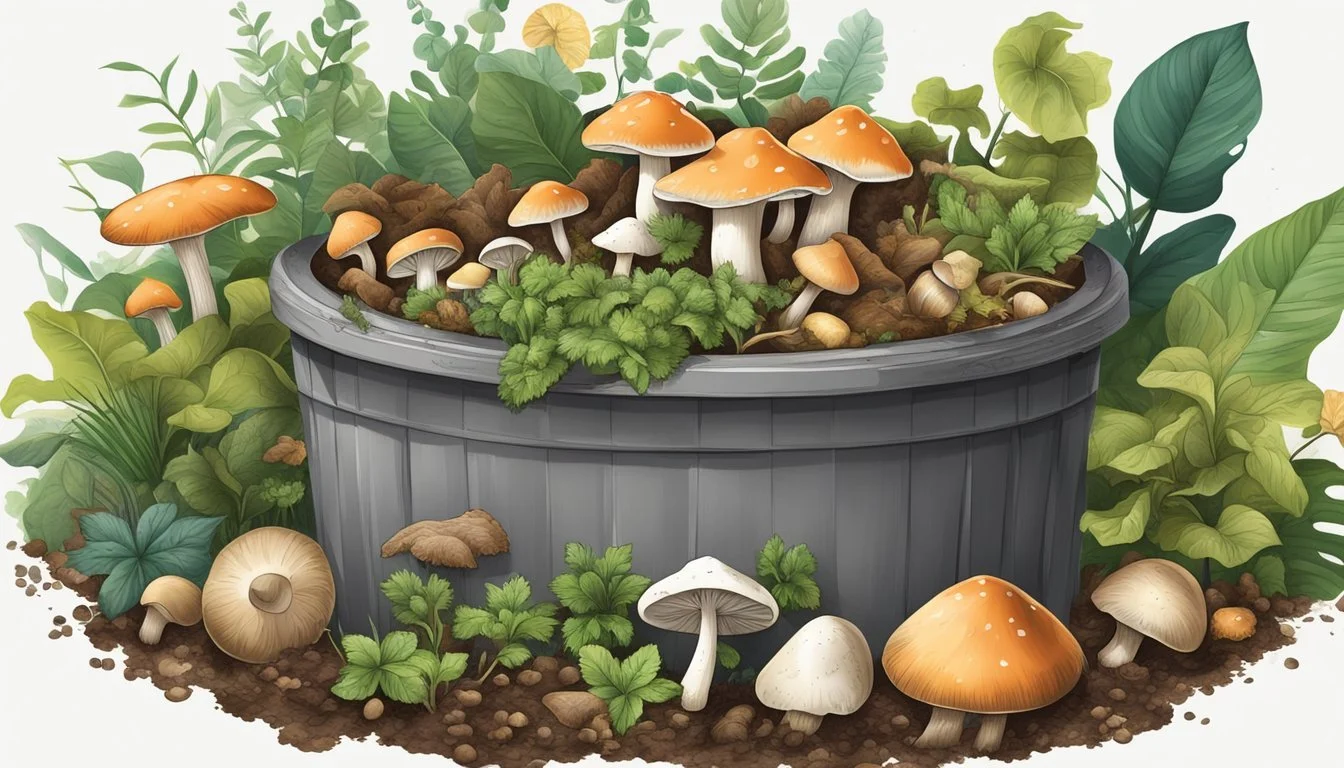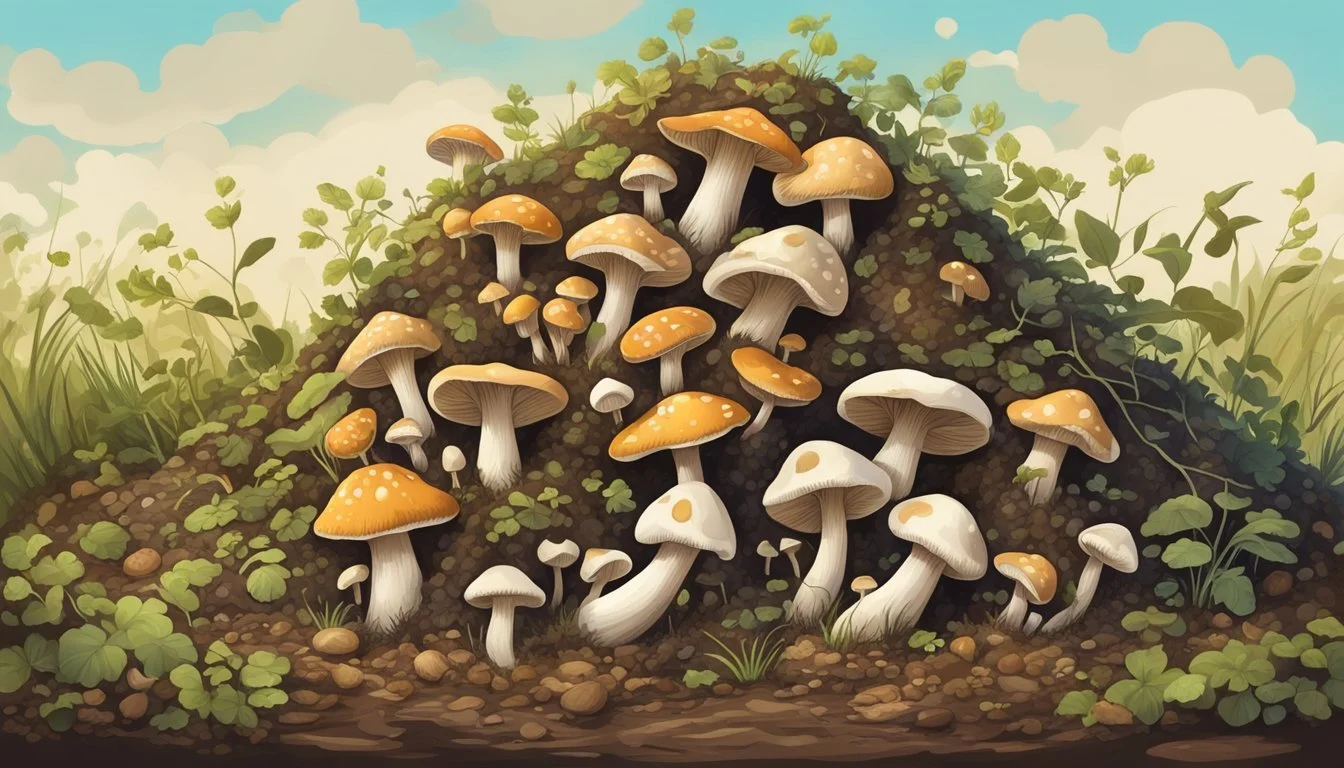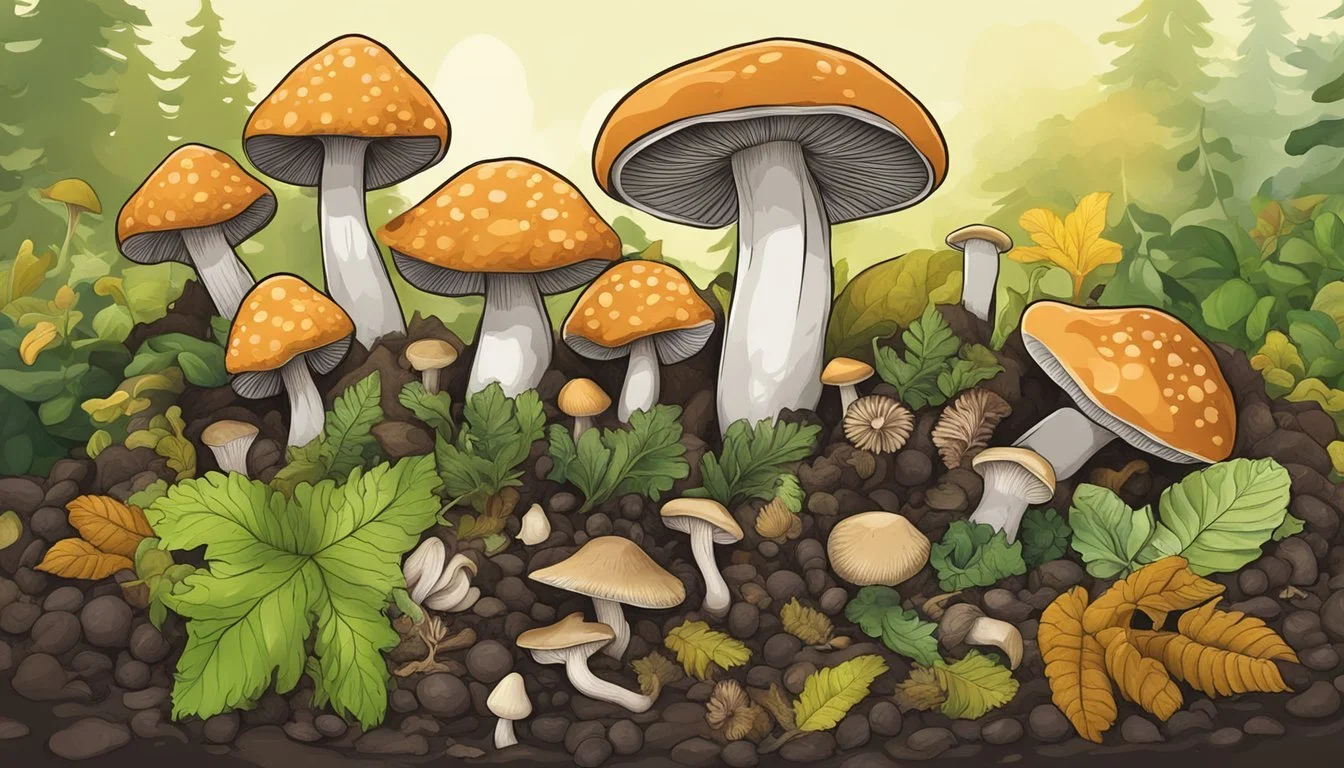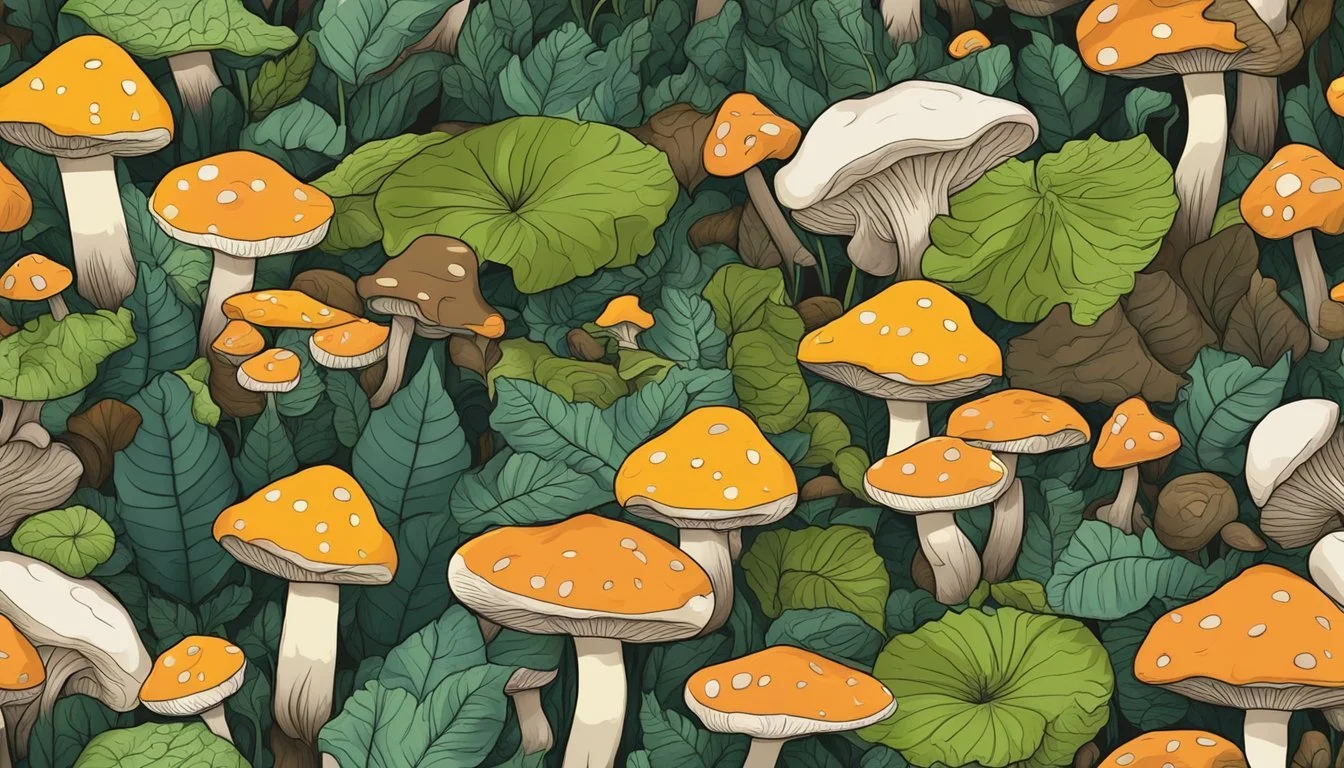Can You Compost Mushrooms?
Insights on Organic Waste Recycling
Mushrooms (What wine goes well with mushrooms?) are an excellent addition to a compost pile, providing numerous benefits to the decomposition process. As a natural source of fungi, incorporating mushrooms into compost adds to the existing fungal mycelium, which is crucial for breaking down organic matter efficiently. This not only accelerates the composting process but also enriches the resulting compost with valuable nutrients.
When composting mushrooms, it's important to recognize that they break down more quickly than most organic wastes. This rapid decomposition releases minerals and other benefits into the compost, enhancing the nutrient profile of the garden soil when it's applied. Although there is a concern that composting mushrooms could lead to the spread of unwanted fungi, this is typically not an issue in a well-maintained compost system.
Mushroom compost, a by-product from mushroom farming, is often confused with composted mushrooms but is distinctly different. After mushrooms are harvested, the growth medium they leave behind, also known as mushroom compost, is rich in organic material and acts as an excellent soil amendment. Both mushroom scraps and mushroom compost can be used effectively within garden environments, playing a significant role in the cultivation of healthy plants.
Basics of Composting
In composting, organic matter decomposes into nutrient-rich soil amendment through a carefully managed process. The key to successful composting lies in balancing the ingredients and maintaining proper conditions for microbial activity.
What is Compost?
Compost is a dark, crumbly, and earthy-smelling material produced by the natural breakdown of organic matter. It results from decomposing food scraps, leaves, and other plant materials, transformed by microorganisms, into a substance rich in nutrients, which can then be used to enrich soil. The process of making compost is driven by the activity of various microorganisms, including bacteria, fungi, and insects, whose work results in the release of nutrients in a form accessible to plants.
Compost Ingredients and Process
Ingredients
The primary ingredients required for composting can be divided into two categories:
Carbon-rich materials ("browns"): These provide energy for microorganisms. Examples include:
Dry leaves
Straw
Paper
Wood chips
Nitrogen-rich materials ("greens"): These materials supply proteins to the microorganisms. Common greens are:
Fruit and vegetable scraps
Coffee grounds
Grass clippings
Manure
Process
The composting process involves four main elements that must be balanced: carbon, nitrogen, moisture, and air. The right mix encourages microorganisms to thrive and break down material efficiently. Here's how each one contributes to the process:
Carbon to Nitrogen Ratio: A ratio of 30:1 carbon to nitrogen is ideal for supporting the decomposition process.
Moisture Levels: Compost should be as moist as a wrung-out sponge to facilitate microorganism activity.
Oxygen: Regularly turning the compost pile introduces oxygen, which is critical for aerobic decomposition.
Temperature: A compost pile should maintain a temperature of between 90-140 degrees Fahrenheit to optimize the activity of decomposers and accelerate the breakdown of organic matter.
Understanding Mushrooms for Composting
The inclusion of mushrooms in a compost pile influences the decomposition process, offering benefits, while also presenting potential challenges that require consideration.
Types of Mushrooms
Mushrooms are classified into edible, wild, and poisonous types. Edible mushrooms such as button, portobello, and shiitake are safe for composting as they are for consumption. Wild mushrooms that sprout in a garden setting can also be composted, provided they are not poisonous. It's crucial to ensure that poisonous mushrooms are not added to the compost to prevent the spread of toxins.
Edible: Button, Portobello, Shiitake
Poisonous: Must be identified and avoided
Benefits of Composting Mushrooms
Mushrooms decompose quickly and contribute nutrients to the compost including carbon, nitrogen, and minerals. They improve the soil structure and water-holding capacity. As part of the decomposition process, mushrooms help to break down organic matter, effectively contributing to the mushroom compost, which is rich in beneficial microorganisms.
Nutrient-rich contribution
Accelerated organic matter breakdown
Enhanced soil quality
Increased water retention
Potential Challenges
While mushrooms are a positive addition to compost, they can introduce certain challenges. There's the potential for mushrooms, particularly wild types, to attract pests or spread spores that could lead to unsolicited fungal growth. Careful monitoring and managing the compost's humidity and temperature can mitigate the risk of pests and unwanted fungi growth.
Risk of introducing pests
Uncontrolled fungal growth
Management of compost conditions
Preparing Mushrooms for Compost
Including mushrooms in your compost can accelerate the decomposition process due to their ability to break down organic material. However, preparation is key to avoiding potential issues with toxicity and ensuring optimal decomposition.
Avoiding Toxic Mushrooms
When adding mushrooms to compost, one must ensure they are not introducing any toxic varieties. Toxic mushrooms can be harmful to both the compost ecosystem and the health of your garden. It is crucial to:
Identify: Only compost mushrooms that you are certain are non-toxic.
Separate: Keep known edible varieties separate from wild ones to prevent cross-contamination.
Optimizing Mushroom Decomposition
To facilitate the decomposition of mushrooms in your compost pile, follow these guidelines:
Size Reduction: Cut or break mushrooms into smaller pieces to hasten decomposition.
Maintain Conditions: Keep the compost pile's moisture and temperature at optimal levels:
Moisture: The pile should be moist but not waterlogged.
Temperature: A warm pile will increase the rate of decomposition without damaging the compost's beneficial microorganisms.
By following these preparation steps, not only do you enrich the compost with nutrients, but you also ensure a more efficient and safer composting process.
The Role of Mushrooms in Soil Health
Mushrooms contribute significantly to soil health by serving as a natural soil amendment, enhancing soil structure through mycelium networks, and supporting plant growth.
Mushroom Compost as Soil Amendment
Mushroom compost, a byproduct of the mushroom growing industry, acts as an excellent soil amendment for garden beds. It is rich in organic matter that, when added to soil:
Improves soil texture, making it more friable and easier for plant roots to grow.
Increases water retention, helping soil hold moisture more efficiently, which is beneficial during dry periods.
Enhances nutrient content, providing plants with vital minerals needed for their growth.
Mycelium and Soil Quality
The mycelium—the vegetative part of a fungus—plays a crucial role in improving soil quality. It forms a vast underground network that connects different plants, enabling them to exchange nutrients and water. Specifically:
Strengthens soil structure, reducing erosion and creating a stable growing environment.
Promotes decomposition, breaking down organic material into nutrients that plants can easily absorb.
Fosters microbial diversity, which is essential for a healthy, productive soil ecosystem.
Mushrooms and Plant Growth
Mushrooms, through their decomposition processes and mycelial networks, facilitate plant growth by:
Acting as a natural plant fertilizer, releasing nutrients such as nitrogen and phosphorus into the soil.
Reducing plant disease, as some fungi have properties that can suppress soil-borne pathogens.
Creating a microhabitat within the soil that benefits root health and encourages robust plant development.
Integrating mushrooms into soil management practices can significantly impact the overall health and productivity of a garden.
Incorporating Mushrooms into Your Compost Pile
Adding mushrooms to a compost pile can enhance the breakdown of organic matter and enrich the resulting compost. However, it is important to apply proper layering techniques, maintain the right conditions, and monitor the pile to prevent unwanted fungal growth.
Layering Techniques
When incorporating mushrooms into a compost pile, it's crucial to balance nitrogen-rich materials with carbon-rich materials. Mushrooms should be layered alongside green waste like grass clippings and kitchen scraps to provide nitrogen. Carbon can be added in the form of brown waste such as dry leaves, wood chips, or straw. A general guideline is to maintain a carbon-to-nitrogen ratio of about 25-30:1.
Start with a carbon-rich base layer to facilitate airflow and drainage.
Add a layer of mushrooms and other nitrogen-rich materials.
Alternate layers of green and brown waste, finishing with a brown layer.
Maintaining Proper Conditions
For optimal composting conditions, ensure the pile maintains:
Moisture levels akin to a wrung-out sponge.
Temperature at the core between 140°F to 160°F to promote decomposition and kill harmful pathogens.
Adequate airflow by occasionally turning the pile.
Condition Optimal Range Moisture Levels Damp (like a wrung-out sponge) Temperature 140°F to 160°F Airflow Regular turning for oxygenation
Monitoring the Compost Pile
Regularly inspect the compost pile for:
White web-like structures indicating active fungal decomposition.
Balancing materials—if the pile is too wet or smells, add brown waste; if too dry, add green waste or water.
Signs of mushroom growth which can indicate good fungal activity but may need control if excessive.
Monitoring involves adjusting the components and turning the pile to ensure even decomposition. It is important for the pile's health and the quality of the finished compost.
Advanced Composting Topics
In advanced composting techniques, the inclusion of mushrooms requires awareness of different composting methods, pest management, and potential for fungal growth.
Hot Composting vs. Vermicomposting
Hot composting is a method that accelerates decomposition by creating high-temperature conditions, which also serves to kill most weed seeds and pathogens. Mushroom spores introduced into a hot compost system are likely to be neutralized by the heat, preventing unintended mushroom growth.
On the other hand, vermicomposting involves the use of worms, typically red wigglers, to break down organic waste at cooler temperatures. Due to the lower temperatures, mushroom spores could potentially survive and proliferate if added to vermicompost. However, the presence of worms aids in achieving a homogenous mixture, facilitating the decomposition of compost mushrooms.
Dealing with Pests and Weeds
In advanced composting, pest and weed management is essential. High temperatures in hot composting effectively kill weed seeds. It's important to maintain a temperature of between 55-65°C (131-149°F) to ensure the destruction of unwanted seeds and any insect larvae.
In vermicomposting, worms are useful for breaking down food scraps and other organics, but they can be vulnerable to predatory insects. Regularly turning the pile and maintaining proper moisture levels can discourage insect infestation. To combat pests, physical barriers or natural predators like nematodes may be introduced.
Mushroom Reproduction in Compost
The reproduction and spread of mushrooms in compost due to mushroom spores is a consideration regardless of the composting method. In hot compost, the elevated temperatures usually inhibit the germination of spores. Conversely, lower temperatures of vermicompost do not guarantee the destruction of spores, potentially yielding mushroom growth within the pile.
A balanced compost that includes a variety of materials alongside mushrooms can reduce the risk of a single organism, such as fungi, overtaking the composting process. Proper aeration and moisture control can further mitigate the risk of excessive fungal proliferation.
Composting Best Practices
When composting mushrooms, it's essential to maintain the proper balance of compost ingredients and ensure adequate moisture and aeration for efficient decomposition.
Balancing Green and Brown Ingredients
A healthy compost pile requires a balanced mix of green (nitrogen-rich) and brown (carbon-rich) materials. Green ingredients include items like fruit scraps, vegetables, and lawn clippings, which provide essential nitrogen. For brown ingredients, one can use leaves, straw, or cardboard, as these add carbon. The ideal ratio is roughly 1 part green to 3 parts brown.
Green Ingredients: Vegetable scraps, fruit waste, lawn clippings
Brown Ingredients: Dry leaves, branches, cardboard
Managing Moisture and Aeration
The compost pile should be kept moist but not wet to support the organisms that break down the material. The aim is akin to the dampness of a wrung-out sponge. Moreover, proper airflow is vital to avoid the creation of anaerobic conditions that may produce unpleasant odors. Regularly turning the compost increases airflow and expedites the composting process.
Moisture Level: Damp to the touch, not saturated
Airflow: Turning compost to introduce air
Compost Maturation
Once the compost pile has been appropriately managed, given time, it will mature into a rich, dark substance. This maturation process typically takes several months to a year, depending on the conditions and materials composted. The finished compost will be crumbly with an earthy odor and ready to use in the garden, completing the cycle of natural waste reuse.
Indicators of Maturity: Dark color, crumbly texture, earthy smell
Time Frame: Several months to one year
Troubleshooting Common Compost Issues
When composting mushrooms, it is important to address common issues that may arise, such as foul odors, unexpected fungal growth, and potential contamination. Addressing these can ensure successful decomposition and a healthy composting process.
Foul Odors and Poor Decomposition
Foul odors often indicate anaerobic conditions within the compost pile. To mitigate these issues, one should:
Ensure adequate aeration: Turning the compost pile regularly introduces oxygen necessary for aerobic decomposition.
Balance moisture levels: The pile should be kept as damp as a wrung-out sponge to prevent over-saturation that leads to bad smells.
Unexpected Mushroom Growth
Mushrooms may start growing in the compost due to their natural role as decomposers. While usually harmless, they can be unsightly or unwelcome:
Monitor moisture and temperature: Keep the compost pile adequately turned and at a proper temperature to discourage mushroom growth.
Adjust green and brown materials: Maintain a balanced ratio of greens (nitrogen-rich) and browns (carbon-rich) to avoid conditions favorable for mushrooms.
Preventing Heavy Metal Contamination
Compost contamination through heavy metals can be detrimental to garden health. To avoid such contamination:
Source mushrooms wisely: Use mushrooms that have been grown in controlled conditions, as wild mushrooms may accumulate heavy metals from the soil.
Be aware of additives: Know the source of all compost materials to prevent introducing contaminants inadvertently.
Compost Application in Gardening
The application of compost in gardening is essential for nutrient supply and soil structure improvement. Specifically, mushroom compost serves well as a fertilizer, can be used for mulching, and should be selected for plants that thrive in its unique composition.
Fertilizing with Compost
Mushroom compost acts as a slow-release fertilizer, providing essential nutrients over time. When incorporated into the soil of a garden or flower beds, it can enhance soil quality by adding organic matter, which improves moisture retention and aeration. It's crucial to apply compost in moderation, as excessive amounts can lead to nutrient imbalances.
Quantity Guideline: Incorporate 2 to 4 inches of compost into the top 6 to 8 inches of soil for optimal results.
Compost and Mulching
Using compost as mulch helps retain soil moisture, suppress weeds, and regulate soil temperature. Mushroom compost, in particular, can be spread on the surface of the soil around plants to form a protective layer, making it beneficial during the dry season or in regions with high temperatures.
Mulch Application: Apply a 2 to 3-inch layer of mushroom compost around the base of plants, avoiding direct contact with stems to prevent rot.
Choosing Plants for Mushroom Compost
Mushroom compost has a high pH level, making it less suitable for acid-loving plants such as blueberries, rhododendrons, and azaleas. However, it is an excellent choice for many other garden plants that prefer neutral to alkaline soil conditions. Gardeners should select plants that will benefit from the alkaline nature and rich nutrient content of mushroom compost.
Alkaline-Friendly Plants: Ornamental plants, vegetables, and herbs often flourish with the addition of mushroom compost to the soil.
Environmental Impact and Sustainability
Composting mushrooms contributes to sustainability by reducing waste and considering climate impacts. The process aligns with environmental conservation efforts, demonstrating both waste reduction and climate mitigation possibilities.
Reducing Waste with Composting
Composting is a key strategy to reduce waste by converting organic matter into nutrient-rich soil amendments. Specifically, composting mushrooms can be an effective method to repurpose what could otherwise become waste. Mushrooms decompose rapidly and enrich compost with minerals, thus diverting them from landfills and reducing methane emissions that occur from organic material decomposition in anaerobic landfill conditions.
Benefits of composting mushrooms include:
Enriching compost with minerals and nutrients
Accelerating the composting process due to rapid decomposition
Reducing landfill waste, thereby minimizing methane production
Climate Considerations
The act of composting has climate considerations, with the composting of mushrooms playing a role in the larger framework of environmental sustainability. The mushroom industry is recognized for its relatively low carbon footprint, especially when compared to other protein and vegetable sources. By processing organic waste through mushroom cultivation and subsequent composting, a sustainable loop is created that consumes less energy and produces fewer greenhouse gases.
Key climate impacts:
Lower carbon footprint: Mushroom composting requires less energy, leading to lower greenhouse gas emissions.
Sustainable agriculture: Utilizing spent mushroom substrate as compost contributes to sustainable agricultural practices by returning nutrients to the soil.







